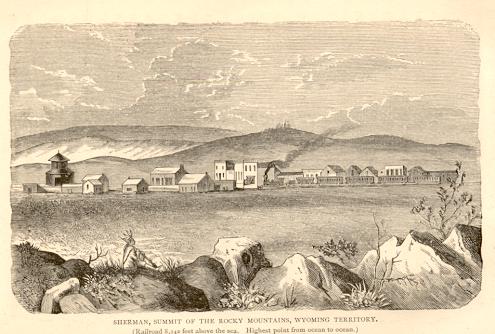
Sherman, Wyoming Terr., 1874, woodcut
Harper's Weekly,
based on photo by C. R. Savage. See Stereograph below.
Sherman, Wyoming, was located a quarter mile from the
Ames Monument discussed on the Preceding Page .
Harper's Weekly frequently used photographs as the
basis for its illustrations. Sometimes the artist would enhance the picture, as in this instance with
the bushes and the train. Compare the
above wood cut with the stereograph by C. R. Savage immediately below.
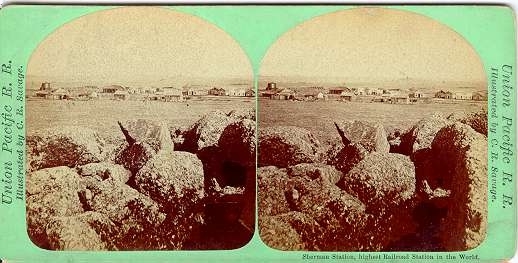
Sherman, approx. 1870, stereograph by C. R. Savage. See close-up on next page.
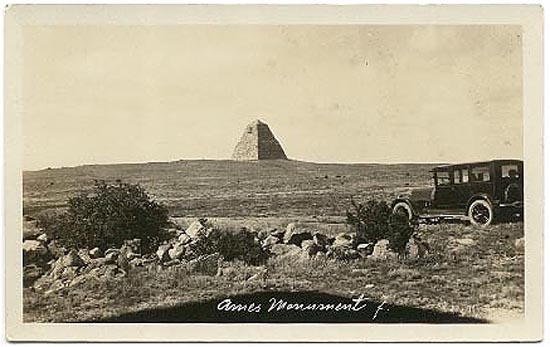
Ames Monument, Sherman, Wyo., photo by
Henning Svenson
For discussion of Henning
Svenson, see Laramie II.
The coming of the railroad had a drastic impact upon Wyoming. As the Railroad progressed across
the Territory small towns and cities sprang up
at the railhead to serve the
needs of the Railroad, the graders and others drawn to the area. Such was
Sherman, seventeen miles east of
Laramie and located at the highest point on the Railroad between the two coasts, 8,262 ft. above sea level.
Sherman was located in an area, at one-time known as "Lone Tree Pass" and later as
Evans Pass, named after James A. Evans (1830-1887), an English-born civil engineer who
discovered the Pass in 1864.
|
Who Discovered Evans Pass?
Controversy exists as to credit for "discovery" of the Pass.
Some writers, including Stephen Ambrose, based on Dodge's 1910 memoir How We Built the Union Pacific Railway, credit discovery of
the pass to General Dodge in September, 1865. Although, in a footnote, Ambrose concedes that Professor
Walter Farnham has described Dodge's claim as "fanciful." Evans ran a survey party in Wyoming during the
1864 "season" which proposed the "Lodge Pole Creek" route for the railroad. In a
March 1865 letter to Dr. Durant, Evans compared various routes through Wyoming including a route
along the Cache Le Poudre, one through Bridger's Pass, and one and through South Pass. Evans not only noted distances,
grades and cost of construction, but the presence of building materials, coal, and
future business for the railroad. Although it is apparent that at the time of
Evans' letter, a final decision had not been made between the Lodge Pole Creek route and the
Cache le Poudre Route, it is also clear that at least a tentative decision was to
be made momentarily. Consulting Engineer Silas Seymour in his 1867 grandiosely titled book,
Incidents of a Trip Through the Great Platte Valley, to the
Rocky Mountains and Laramie Plains, in the Fall of 1866, with a Synoptical Statement of the
Various Pacific Railroads, and an Account of the Great Union Pacific Railroad Excursion to
the One Hundredth Meridian of Longitude, notes that the route was surveyed by Evans in 1865 and seemingly
gives credit to Evans:
After following the travelled road to a point within about two miles of the Willow Spring
Station, we diverged to the left, in a more northerly direction, and
ascended the westerly slope of the Black Hills to a depression in their
summit, some miles north of Antelope Pass, and considerably to the south
of Cheyenne Pass, named Evans' Pass, in honor of the Engineer of that name,
who formed one of our party; and to whose energy, and skill in his
profession, the Railroad Company are indebted for most of the information
in their possession respecting the region over which we were travelling.
The actual "final-final" decision was not made until November 1866. It is clear that
a determination had been made by early 1865, before Dodge's "discovery", that a route near
present day Cheyenne was feasible. No such decision would have been
made unless there was also a determination as to how the Black Hills, now known as the Laramie
Mountains, could be crossed. Of course, there are indications that the preliminary decision was a
route north of present day Cheyenne through Cheyenne Pass following the old
Lodgepole Trail. The Lodgepole Trail was about 12 miles north of present day Cheyenne and
passed near present day Federal south of Horse Creek. Indeed, in 1865,
Evans surveyed an "experimental" route through Cheyenne Pass and calculations of
grades, etc. were made. Evans also laid out an experimental route through what was to become
Evans Pass. Both Jesse L. Williams, an engineer and a government director of the
railroad who accompanied Seymour on his inspection tour, and Seymour give Evans credit for having
surveyed Evans Pass.
The only question left by the end of 1865 was whether
the route would be via present day Cheyenne or via a route basically following the
old Cherokee Trail. The final decision took into account the very factors discussed by
Evans in his March 1865 letter, grades, building materials, and coal, and yet be
as close to Denver as practicable. Dodge, as to his accomplishments, is one not known for
undue modesty. Thus, Professor Larson has noted that Dodge over the years gave
different versions of the discovery. Ambrose takes Dodge's history of the
building of the railroad as striking Ambrose "as true." Farnham, "Grenville Dodge and
the Union Pacific: A study of Historical Legends," Journal of American History, March
1965, tends not to believe
Dodge in many details. Professor Larson accepts Dodge's claim but with a grain of
salt, and notes that Dodge exaggerated his involvement in the actual construction of
the railroad. Larson continues:
"Farnham has stripped [Dodge's] discovery of its romantic embroidery by directing attention
to Dodge's diary, in which there is no mention of Indians but only of 'Indian signs' on the day
the gangplank was found." Larson, History of Wyoming, p. 39-40. (Dodge claimed that the
discovery was made after an encounter with and subsequent escape from a large party of Indians).
For description of the "Gangplank" see
discussion under Lincoln Highway. Edwin L. Sabin, Building the Pacific Railway: The construction story of American's Firt Iron
Thoroughfare, J. B. Lippincutt company, 1919, takes the position that Dodge
discovered the pass, lost it, and sent Evans out to rediscover it.
It should be noted that the pass was known as
"Evans Pass" as early as 1866 during Seymour's tour of the Black Hills with Evans, Dodge, and Williams. Dodge made his
claim of discovery in 1910, 45 years after the event when Dodge's memory may have been suffering
from the frailties of age, and 23 years after
Evans went to his grave and, thus, could not refute any of
Dodge's claims. The definitive answer, however appears in the testimony of Cornelius Scranton Bushnell (1829-1896), one
of the incorporators of the railroad, before the Select Committee of the House
of Representatives in relation to the affairs of the Union Pacific Railroad Company, Jan. 15, 1873. Mr.
Bushnell unequivocally gives credit to Evans. Bushnell was a highly respected entrepreneur whose investment
in the USS Monitor saved the United States Navy from the onslaughts of the CSS Virginia. The possibility exists, of course, that Dodge "discovered" the pass and Evans surveyed it.
With, however, all due respect to Professor Larson, it appears likely, based on contemporeous reports,
credit for the discovery is due James A. Evans, with the actual route through the pass being
selected by Seymour based on his inspection tour.
|
Albert D. Richardson, a correspondent for the
New York Tribune wrote of Sherman in "Through to the Pacific," 1869:
Sherman is the highest railway point in the world -- eight thousand two hundred and forty feet
above the sea. Still, it is not the backbone of the Rocky Mountains, but only of the
Black Hills, an outlying eastern range. The continental divide is two hundred miles
further west and one thousand feet lower. Sherman is in Evan's Pass, which bears the
name of its discoverer. He was one of many martys to this great work -- a
Union Pacific surveyor, killed by the Indians. The pass is in no sense a
gorge or canyon -- but looks, topographically, like a vast rolling
prairie disfigured by rocks and reached by a gentle ascent. Nor are
the distant mountains on the north and south such slender peaks and pyramids as
fanciful artists depict, but only low, irregular, broken ridges.
The description of the topography is accurate. The death of Evans at the
hands of the Indians was, however, premature. Little has been written of
Evans, after whom Evanston, Wyoming is named. In Stephen Ambrose's history of the construction of the
Pacific Railroad, Nothing Like it in the World, Simon & Schuster, New York, 2000, Evans arrives
upon the scene in 1864 with his employment by then Chief Engineer, Peter Anthony Dey. Dey
resigned as Chief Engineer at the end of 1864 in a dispute with Consulting Engineer Silas
Seymour and Dr. Durant over apparent efforts to pad the cost of the railroad construction. Evans
disappears from Ambrose's book with an 1868 telegram from Durant to Evans: "Notify Casement
that 16,000 feet of track per day won't do," and an observation several pages later that Evanston was named
after Evans.
It has been said that the most enduring relics of those who have gone before will be found in
names. It is thus in Cheyenne. In the streets of the downtown area are found the names of the
early engineers of and officials of the railroad officials who built the Union Pacific: Evans Ave. (James A. Evans, Division
Engineer), Seymour Ave. (Silas Seymour, Consulting Engineer), Maxwell Ave. (James Riddle Maxwell, civil engineer),
Peter A. Dey (Chief Engineer), Reed Ave. (Samuel B. Reed, Division Engineer), Dillon Ave. (Sidney Dillon, Director), Bent Ave.
(Luther S. Bent, contractor).
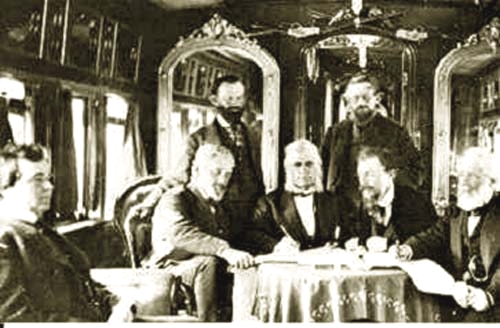
At Table, L to R: Consulting Engineer, Silas
Seymour; Railroad Director, Sidney Dillon; Railroad Vice President, Thomas Durant;
Railroad Director, John Duff.
Disputes between the engineers in the field and Seymour were not uncommon. Seymour had made his
fame by having his route selected for the New York and Erie Railroad over two
competing proposed routes. Thereafter, he served as the New York State Engineer having
responsibilities for mapping of Upstate New York and with regard to the
State-owned Erie Canal. For a short period of time he also served as the
Engineer for the Kansas and Pacific. Most of the railroad engineers of the day
preferred stone or iron bridges. Seymour preferred cheaper wooden "Howe Truss" bridges. One
source even indicates that Seymour wanted to use longitudinal wooden timbers under the
rails in lieu of crossties. Among the wooden bridges designed by Seymour was the
terrifying Dale Creek Bridge which would sway in the wind (photos and discussion on
subsequent page). The bridge was replaced after only
eight years. It will be recalled all of the wooden bridges on the
Union Pacific ultimately had to be replaced, leading in part to the railroad's
financial difficulties in the 1880's.
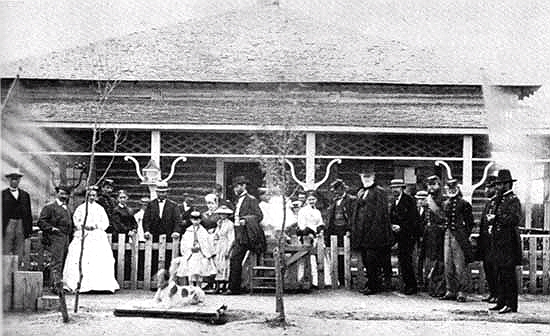
Participants at Meeting at Fort Sanders, July
1868
Left to Right: Sidney Dillon: Gen. P. H. Sheridan: Mrs. Joseph H. Potter:
Gen. John Gibbon; Mrs. John Gibbon; 13 year-old John Gibbon, Jr.; Gen. U. S. Grant (with hands on fence),
Col. (Bvt. Brig. Gen.) Frederick T. Dent, military secretary to Gen. Grant;
unidentified woman and young ladies; Gen. Wm. T. Sherman (sitting on stile); unidentified woman and
children; unidentified; Mrs. John W. Bubb;
Capt. Mail; Mrs. Lincoln Kilbourn; Brig. Gen. Adam Jacoby Slammer; Gen. W. S. Harney (with white beard and cape),
Dr. Thomas Durant (with hands clasped); unidentified; Lt. John S. Bishop; Col. (Brig. Gen. Volunteers) Lewis Cass Hunt; Brig. Gen Adam Kautz;
Lt. Col. (Bvt. Brig. Gen.) Joseph H. Potter, commander Ft. Sanders.
In July 1868, a showdown occurred at Ft. Sanders between Gen. Dodge and Durant, over
engineering of the Railroad. Things had begun to boil before the meeting in a dispute between
Seymour and Dodge over the proposed route of the railroad. The dispute is somewhat
reminiscent of the dispute that led to Dey's resignation and a concern expressed in
Evans' 1865 letter to Durant. In the letter, Evans notes that he had previously written Dr. Durant and
entrusted the letter to Seymour, but thought that Durant may have not received it.
Evans wrote Dodge at the time of the showdown offering his resignation should Dodge be removed. At the meeting at
Ft. Sanders, Gen. Grant, even though he had not yet gone through the formality of being
elected President, made it clear that the government expected Gen. Dodge to be the engineer. Following
the completion of the Railroad, Dodge became the president of the Texas and
Pacific. Evans was chief engineer of the Western Division (never actually built), living in San Diego. Later Evans was chief engineer for the
Denver, South Park, and Pacific, living in Denver, with wife Jessie, brother John A. Evans, also
a civil engineer, and child.
Next Page, Sherman continued.
|